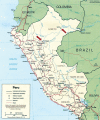Itaya virus, a Novel Orthobunyavirus Associated with Human Febrile Illness, Peru
- PMID: 25898901
- PMCID: PMC4412221
- DOI: 10.3201/eid2105.141368
Itaya virus, a Novel Orthobunyavirus Associated with Human Febrile Illness, Peru
Abstract
Our genetic analyses of uncharacterized bunyaviruses isolated in Peru identified a possible reassortant virus containing small and large gene segment sequences closely related to the Caraparu virus and a medium gene segment sequence potentially derived from an unidentified group C orthobunyavirus. Neutralization tests confirmed serologic distinction among the newly identified virus and the prototype and Caraparu strains. This virus, named Itaya, was isolated in 1999 and 2006 from febrile patients in the cities of Iquitos and Yurimaguas in Peru. The geographic distance between the 2 cases suggests that the Itaya virus could be widely distributed throughout the Amazon basin in northeastern Peru. Identification of a new Orthobunyavirus species that causes febrile disease in humans reinforces the need to expand viral disease surveillance in tropical regions of South America.
Keywords: Amazon; Caraparu virus; Itaya; Orthobunyavirus; Peru; arboviruses; bunyavirus; febrile surveillance; human pathogen; vector-borne infections; viruses.
Figures




References
-
- Yanase T, Kato T, Aizawa M, Shuto Y, Shirafuji H, Yamakawa M, et al. Genetic reassortment between Sathuperi and Shamonda viruses of the genus Orthobunyavirus in nature: implications for their genetic relationship to Schmallenberg virus. Arch Virol. 2012;157:1611–6. 10.1007/s00705-012-1341-8 - DOI - PubMed
Publication types
MeSH terms
Substances
Grants and funding
LinkOut - more resources
Full Text Sources
Other Literature Sources
Medical
Molecular Biology Databases

